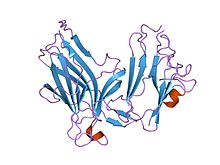Our website is made possible by displaying online advertisements to our visitors.
Please consider supporting us by disabling your ad blocker.
Ephrin
| Ephrin | |||||||||
|---|---|---|---|---|---|---|---|---|---|
 Ectodomains of the Ephb4-Ephrinb2 protein complex | |||||||||
| Identifiers | |||||||||
| Symbol | Ephrin | ||||||||
| Pfam | PF00812 | ||||||||
| Pfam clan | CL0026 | ||||||||
| InterPro | IPR001799 | ||||||||
| PROSITE | PDOC01003 | ||||||||
| SCOP2 | 1kgy / SCOPe / SUPFAM | ||||||||
| CDD | cd02675 | ||||||||
| Membranome | 70 | ||||||||
| |||||||||
Ephrins (also known as ephrin ligands or Eph family receptor interacting proteins) are a family of proteins that serve as the ligands of the Eph receptor. Eph receptors in turn compose the largest known subfamily of receptor protein-tyrosine kinases (RTKs).
Since ephrin ligands (ephrins) and Eph receptors (Ephs) are both membrane-bound proteins, binding and activation of Eph/ephrin intracellular signaling pathways can only occur via direct cell–cell interaction. Eph/ephrin signaling regulates a variety of biological processes during embryonic development including the guidance of axon growth cones,[1] formation of tissue boundaries,[2] cell migration, and segmentation.[3] Additionally, Eph/ephrin signaling has been identified to play a critical role in the maintenance of several processes during adulthood including long-term potentiation,[4] angiogenesis,[5] and stem cell differentiation.[6]
- ^ Egea J, Klein R (May 2007). "Bidirectional Eph-ephrin signaling during axon guidance". Trends in Cell Biology. 17 (5): 230–238. doi:10.1016/j.tcb.2007.03.004. PMID 17420126.
- ^ Rohani N, Canty L, Luu O, Fagotto F, Winklbauer R (Mar 2011). Hamada H (ed.). "EphrinB/EphB signaling controls embryonic germ layer separation by contact-induced cell detachment". PLOS Biology. 9 (3): e1000597. doi:10.1371/journal.pbio.1000597. PMC 3046958. PMID 21390298.
- ^ Davy A, Soriano P (Jan 2005). "Ephrin signaling in vivo: look both ways". Developmental Dynamics. 232 (1): 1–10. doi:10.1002/dvdy.20200. PMID 15580616. S2CID 37808863.
- ^ Kullander K, Klein R (Jul 2002). "Mechanisms and functions of Eph and ephrin signalling". Nature Reviews Molecular Cell Biology. 3 (7): 475–486. doi:10.1038/nrm856. PMID 12094214. S2CID 1735440.
- ^ Kuijper S, Turner CJ, Adams RH (Jul 2007). "Regulation of angiogenesis by Eph-ephrin interactions". Trends in Cardiovascular Medicine. 17 (5): 145–151. doi:10.1016/j.tcm.2007.03.003. PMID 17574121.
- ^ Genander M, Frisén J (Oct 2010). "Ephrins and Eph receptors in stem cells and cancer". Current Opinion in Cell Biology. 22 (5): 611–616. doi:10.1016/j.ceb.2010.08.005. PMID 20810264.
Previous Page Next Page


